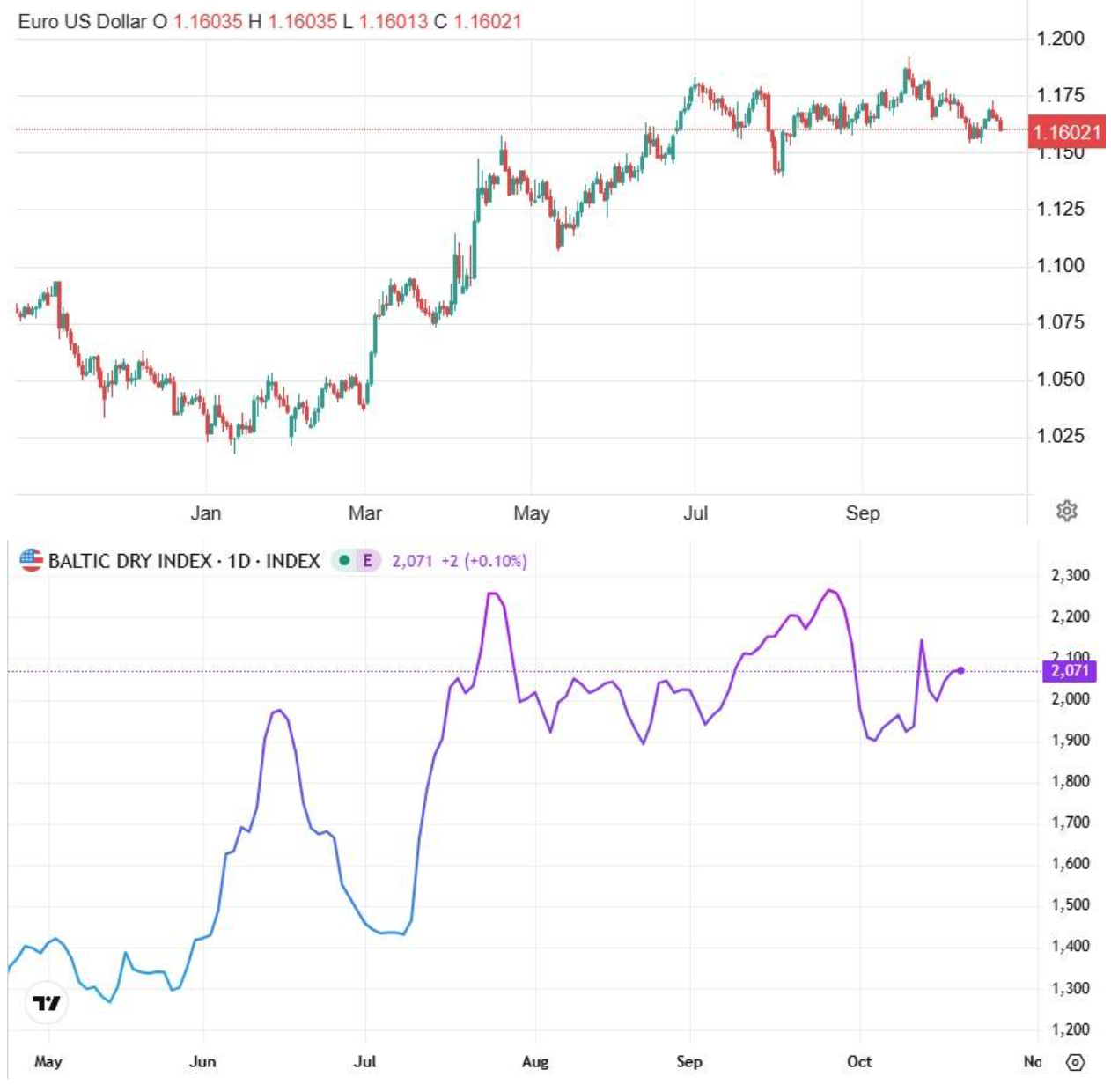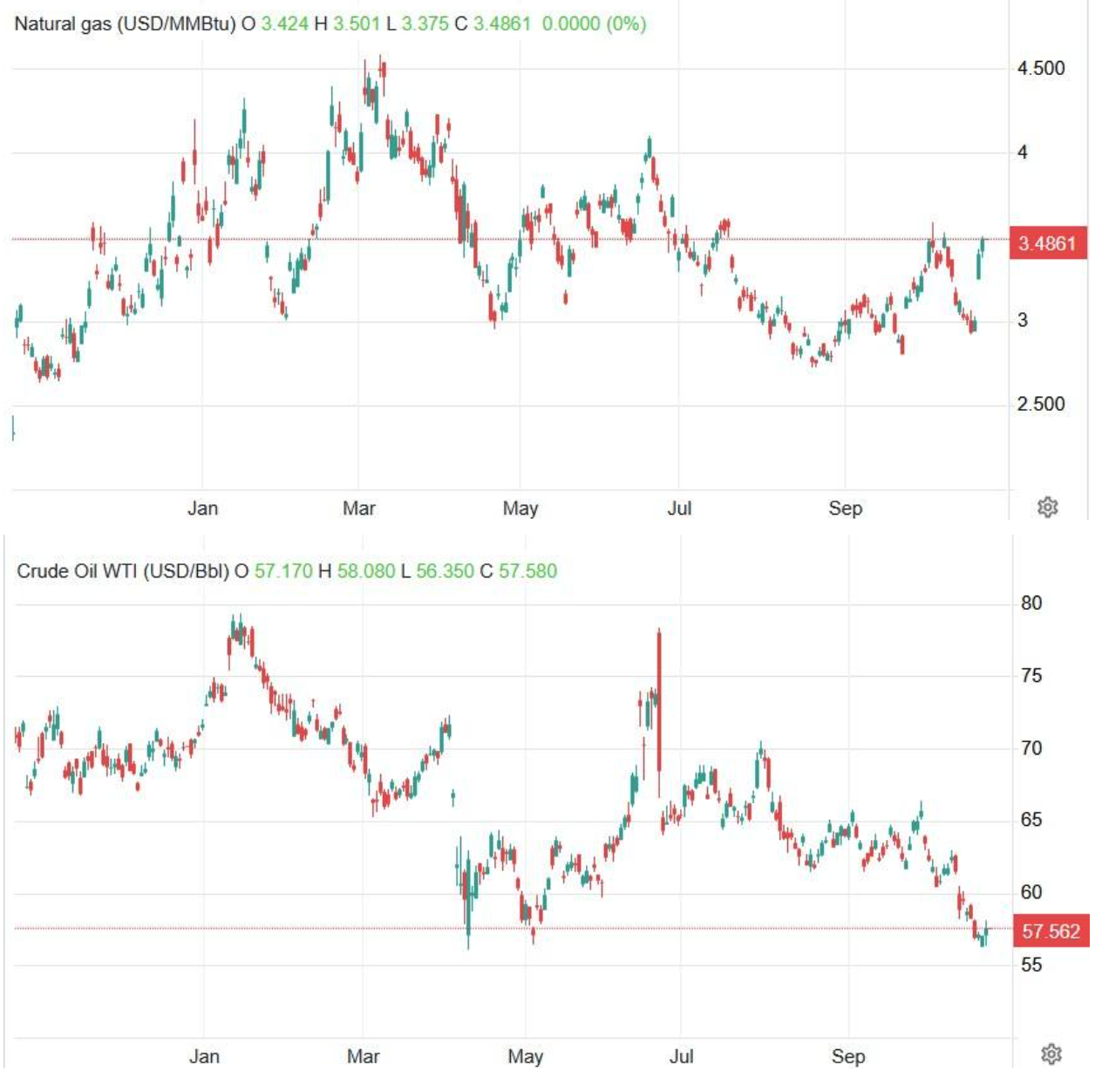The global economy stands at a new turning point.
Wall Street remains optimistic, with indices at historical highs. The United States is moving with confidence, leveraging the momentum of production and its energy independence, while Europe remains cautious, struggling to balance between stability and strategic rigidity.
De-escalation in Gaza, the forthcoming peace in Ukraine, and the first interest-rate cuts are changing the landscape, bringing new prospects for markets and shipping. At the same time, Europe opts for a more sober pace, seeking, through misguided moves and policies, stability and balance. Within this setting, the shift in monetary policy, the change in Jerome Powell’s tone, and the geopolitical de-escalations in Ukraine and the Middle East compose a new narrative in global markets.
America is once again showing its resilience. Jerome Powell’s recent remarks signaled a clear change of tone from the Federal Reserve: instead of stern inflation warnings, Powell spoke of an “expected soft landing for the economy” and of “gradual rate cuts” if conditions permit. This rhetorical shift, as we have emphasized in all our articles, was anticipated and sufficient to change the mood on Wall Street; markets read the message as confirmation that the era of obsessive monetary tightness is coming to an end. The result was a fresh push in equities, especially in sectors with high-rate sensitivity such as technology, consumer goods, and real estate.
At the policy level, the philosophy and persistence in the Make America Great Again strategy appear to be gaining real economic depth. Strengthening industrial production, investing in domestic infrastructure, and reviving manufacturing acts as pillars of confidence. The combination of lower rates and investment dynamism reinforces the image of an economy reaffirming its self-confidence. Trump’s tariffs are among the most decisive, yet most misunderstood, politico-economic moves of recent decades.
Many saw them at the time as “protectionism” (not us, however, as we stressed the existence of a specific strategy with a strict implementation timeline); in practice, they functioned as a strategic tool for reshoring production, restoring negotiating power, and strengthening public finances.
Europe is moving with sobriety, but the risk of losing momentum is visible. Peace in Ukraine creates reconstruction opportunities, yet strategic rigidity and energy dependence keep the continent in a fragile balance. The proposal from Brussels to permanently stop imports of Russian natural gas by 2028 once again has political depth, but wrongly so, and carries a serious economic cost:
- Higher energy and production costs.
- Dependence on more expensive LNG (U.S., Qatar).
- Pressure on heavy industry and shrinking competitiveness.
If Europe does not act smartly and realistically, politically, especially on the Ukrainian issue, and does not seek a gradual normalization of trade relations with Russia, it risks seeing its economy contract, losing productivity and investment to the U.S. and Asia. America moves with boldness and confidence. If Europe proceeds with realism and cooperation, it can emerge stronger. But if it remains trapped in ideological fixations and anti-Russian dogmatism, then the contraction of the European economy will be only a matter of time.
The global market is moving between Wall Street’s optimism and Europe’s sobriety, and history will show which of the two proves wiser. The inability of Europe’s leaders to adapt to the new geoeconomic reality puts pressure on the euro. Rising energy costs weaken production. Growth remains anemic, political uncertainty (France, Central Europe) undermines investor confidence; if the narrative does not change, if Europe continues to lead with fear instead of vision, with impulsiveness instead of policy—the common currency risks moving lower, initially perhaps into the $1.05–$1.10 range, as investors seek safety in the USD. In the end, the euro reflects Europe’s self-confidence, and in our view, that remains constrained and will prove particularly misguided. The mood will tilt further in America’s favor when insecurity begins to give way to stability and optimism.
De-escalation in Gaza and talks for a lasting peace are radically changing the climate in the Middle East. Energy flows are stabilizing, risk along sea routes is declining, and markets are reacting positively with lower insurance premium and oil-shipping freight rates. The region’s energy calm acts as a preventive antidote to the volatility that dominated the past two years. Global shipping reflects the path toward stability more than any other sector. The result is easily evidenced by the performance of the Baltic Dry, whose move toward 2,000 points we highlighted early in the year, and by the continuation, in our latest articles, of this positive momentum. The imminent peace in Ukraine is expected to revive shipments of grains, metals, and construction materials, strengthening the dry bulk segment. The reopening of the ports of Odesa and Mykolaiv will bring new commercial activity and upgrade the region’s importance in global trade. De-escalation in Gaza restores security in the Suez Canal, reducing costs and delays on Asia-Europe routes. Europe’s proposal to wean itself off Russian energy is reshaping the geography of trade, increasing demand for LNG carriers. While this benefits the shipping sector in the short term, it intensifies Europe’s long-term energy pressure. Thus, shipping emerges not only as a profit-making industry but also as a global barometer of political balance.
At the same time, Europe sees the end of the war in Ukraine approaching, but without the will to benefit. The gradual de-escalation of hostilities and the intensification of negotiations by President Trump alone create expectations for a plan of peaceful reconstruction that will mobilize funds, infrastructure companies, and investment vehicles across the continent. This “post-war” phase, as we have stressed, will act as a catalyst for growth, especially in sectors such as energy, construction, and agri-tech. And this perpetually negative stance by Europe will ultimately yield all those negative multiplier effects we have mentioned in many of our articles, since the protagonists in Ukraine’s reconstruction will be primarily of American interest.
Markets are entering a new era of balance in which risk and opportunity coexist creatively: the U.S. benefits from confidence psychology, a more accommodative monetary environment, and a national investment pivot. Investors see an environment more friendly to risk, where diversification and selectivity regain meaning. In my view, the positive momentum is only now beginning to show that it is gaining force, flesh, and bones; the period until now was simply a first stage of awakening. There is massive capital sitting outside risk in many investment products, and we expect to see significant outflows from them. Many speak about gold. We have already expressed our view in previous articles: you should be very careful with the movement of this specific asset.
2025 appears to mark the beginning of a global restart.
America, with Make America Great Again returning as active economic policy, is confidently leading global growth. The (expected) change in Jerome Powell’s tone was perhaps the most resonant message of recent months: markets need confidence, not fear, and monetary policy is returning to the logic of balance.
For the investor, this is the inflection point: the shift from defense to selective risk-taking, with emphasis on technology, energy, infrastructure, and sectors that benefit from lower rates and geopolitical stability. The global market indeed stands between Wall Street’s optimism and Europe’s sobriety. America shows that a strategy grounded in self-confidence pays off. The United States, through Trump’s policies, gained autonomy, revenues, and confidence. Europe—trapped in management rather than creation, risks falling behind. History shows that markets always reward those who dare to redesign the rules, and Make America Great Again proved this in practice.
I emphasize all this so that you can better decipher what you read, when and how to assess it, to exploit opportunities in the most optimal way. As I have stated many times, markets are forward-looking, and this is precisely the core reason to work with an investment advisor: to see further ahead, to judge with composure, and to take positions at the moment when others still hesitate.

by Kotsiakis George









